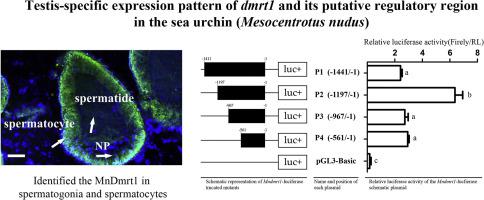Comparative Biochemistry and Physiology B: Biochemistry & Molecular Biology ( IF 2.2 ) Pub Date : 2021-08-09 , DOI: 10.1016/j.cbpb.2021.110668 Zhouping Cui 1 , Jian Zhang 2 , Zhihui Sun 1 , Bingzheng Liu 1 , Yalun Han 1 , Chong Zhao 1 , Yaqing Chang 1

|
Sea urchin (Mseocentrotus nudus) is an economically important mariculture species in several Asian countries. The growth rate and immunocompetence differ by sex in this species. However, the mechanisms of sex determination in M. nudus have remain unclear. In the present study, we focus on the dmrt1 gene of M. nudus (Mndmrt1) to investigate its dynamic expression pattern during different developmental stages. Real-time quantitative PCR (RT-qPCR) revealed that Mndmrt1 exhibits testis-specific expression and undetectable during the whole embryogenesis. With the development of ontogenetic, Mndmrt1 transcripts are first detected at 9 months post-fertilization (mpf). In addition, both the transcripts and protein of Mndmrt1 gene were specifically expressed in spermatogonia and spermatocytes, indicating that it might be a male germ cells marker in sea urchin. Significantly, the 1441 bp promoter sequence of Mndmrt1 gene was obtained by DNA walking, and one positive regulatory region at −1197/ −968 in the promoter, as well as one negative regulatory region at −1441/ −1198 have been identified by promoter activity analysis. Moreover, two regulatory regions contain multiple putative binding sites for transcription factors, including Sp1, Egr1, Sox5, CEBP, GATA and SRY. These findings suggest that Mndmrt1 may be related to testis differentiation and spermatogenesis in sea urchin and will provide an insight into understanding the regulatory mechanism of the dmrt1 gene.
中文翻译:

海胆 (Mesocentrotus nudus) 中 dmrt1 及其假定调控区的睾丸特异性表达模式
海胆(Mseocentrotus nudus)是几个亚洲国家经济上重要的海水养殖物种。该物种的生长速度和免疫能力因性别而异。然而,M. nudus的性别决定机制仍不清楚。在本研究中,我们将重点关注裸鼠的dmrt1 基因( Mndmrt1 ),以研究其在不同发育阶段的动态表达模式。实时定量 PCR (RT-qPCR) 显示Mndmrt1表现出睾丸特异性表达,并且在整个胚胎发生过程中无法检测到。随着个体发育的发展,Mndmrt1在受精后 9 个月 (mpf) 首次检测到转录本。此外,Mndmrt1基因的转录本和蛋白均在精原细胞和精母细胞中特异性表达,表明它可能是海胆中雄性生殖细胞的标志物。值得注意的是, Mndmrt1基因的1441 bp启动子序列是通过DNA步行获得的,启动子中-1197/-968处的一个正调控区和-1441/-1198处的一个负调控区已通过启动子活性鉴定。分析。此外,两个调控区域包含多个假定的转录因子结合位点,包括 Sp1、Egr1、Sox5、CEBP、GATA 和 SRY。这些发现表明Mndmrt1可能与海胆的睾丸分化和精子发生有关,并将为理解dmrt1基因的调控机制提供见解。


























 京公网安备 11010802027423号
京公网安备 11010802027423号